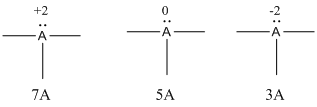
Concept explainers
(a)
Interpretation:
The formal charges of element A if it was in (a) Group 7A, (b) Group 5A, (c) Group 3A should be drawn.
Concept Introduction
- A formal charge (FC) is the charge assigned to an atom in a molecule, irrespective of relative electronegativity by thinking that electrons in all
chemical bonds are shared equally among atoms. - This method is used to identify the most probable Lewis structures if more than one possibility exists for a compound.
- Formal charge of an atom can be determined by the given formula.
To determine: Formal charge of the given species
(a)
Answer to Problem 5PPC

Explanation of Solution
Given Lewis structure

A formal charge (FC) is the charge assigned to an atom in a molecule, irrespective of relative electronegativity.
The formal charge of the given species is calculated,
- If A is group 7A, then number of valence electrons is 7
Substituting these values to the equation,
- If A is group 5A, then number of valence electrons is 5
Substituting these values to the equation,
- If A is group 3A, then number of valence electrons is 3
Substituting these values to the equation,
Therefore,
The formal charges are,

(b)
Interpretation:
The formal charges of element A if it was in (a) Group 7A, (b) Group 5A, (c) Group 3A should be drawn.
Concept Introduction
- A formal charge (FC) is the charge assigned to an atom in a molecule, irrespective of relative electronegativity by thinking that electrons in all chemical bonds are shared equally among atoms.
- This method is used to identify the most probable Lewis structures if more than one possibility exists for a compound.
- Formal charge of an atom can be determined by the given formula.
To determine: Formal charge of the given species
(b)
Answer to Problem 5PPC

Explanation of Solution
Given Lewis structure

A formal charge (FC) is the charge assigned to an atom in a molecule, irrespective of relative electronegativity.
The formal charge of the given species is calculated,
- If A is group 7A, then number of valence electrons is 7
Substituting these values to the equation,
- If A is group 5A, then number of valence electrons is 5
Substituting these values to the equation,
- If A is group 3A, then number of valence electrons is 3
Substituting these values to the equation,
Therefore,
The formal charges are,

(c)
Interpretation:
The formal charges of element A if it was in (a) Group 7A, (b) Group 5A, (c) Group 3A should be drawn.
Concept Introduction
- A formal charge (FC) is the charge assigned to an atom in a molecule, irrespective of relative electronegativity by thinking that electrons in all chemical bonds are shared equally among atoms.
- This method is used to identify the most probable Lewis structures if more than one possibility exists for a compound.
- Formal charge of an atom can be determined by the given formula.
To determine: Formal charge of the given species
(c)
Answer to Problem 5PPC

Explanation of Solution
Given Lewis structure

A formal charge (FC) is the charge assigned to an atom in a molecule, irrespective of relative electronegativity.
The formal charge of the given species is calculated,
- If A is group 7A, then number of valence electrons is 7
Substituting these values to the equation,
- If A is group 5A, then number of valence electrons is 5
Substituting these values to the equation,
- If A is group 3A, then number of valence electrons is 3
Substituting these values to the equation,
Therefore,
The formal charges are,

Want to see more full solutions like this?
Chapter 6 Solutions
Chemistry Atoms First, Second Edition
- What alkene or alkyne yields the following products after oxidative cleavage with ozone? Click the "draw structure" button to launch the drawing utility. draw structure ... andarrow_forwardDraw the products of the stronger acid protonating the other reactant. H3C-C=C-4 NH2 KEq CH H3C `CH3 Product acid Product basearrow_forward2. Draw the missing structure(s) in each of the following reactions. The missing structure(s) can be a starting material or the major reaction product(s). C5H10 Br H-Br CH2Cl2 + enant.arrow_forward
- Draw the products of the stronger acid protonating the other reactant. KEq H₂C-O-H H3C OH Product acid Product basearrow_forwardDraw the products of the stronger acid protonating the other reactant. OH KEq CH H3C H3C `CH3 Product acid Product basearrow_forward2. Draw the missing structure(s) in each of the following reactions. The missing structure(s) can be a starting material or the major reaction product(s). Ph H-I CH2Cl2arrow_forward
- 3 attempts left Check my work Draw the products formed in the following oxidative cleavage. [1] 03 [2] H₂O draw structure ... lower mass product draw structure ... higher mass productarrow_forward2. Draw the missing structure(s) in each of the following reactions. The missing structure(s) can be a starting material or the major reaction product(s). H-Br CH2Cl2arrow_forwardWrite the aldol condensation mechanism and product for benzaldehyde + cyclohexanone in a base. Then trans-cinnamaldehyde + acetone in base. Then, trans-cinnamaldehyde + cyclohexanone in a base.arrow_forward
 Chemistry: The Molecular ScienceChemistryISBN:9781285199047Author:John W. Moore, Conrad L. StanitskiPublisher:Cengage Learning
Chemistry: The Molecular ScienceChemistryISBN:9781285199047Author:John W. Moore, Conrad L. StanitskiPublisher:Cengage Learning
